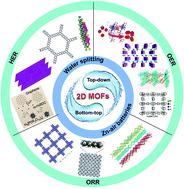Our official English website, www.x-mol.net, welcomes your feedback! (Note: you will need to create a separate account there.)
Recent development of two-dimensional metal-organic framework derived electrocatalysts for hydrogen and oxygen electrocatalysis.
Nanoscale ( IF 6.7 ) Pub Date : 2020-07-30 , DOI: 10.1039/d0nr04458j Hengbo Wu 1 , Jie Wang , Wei Jin , Zexing Wu
Nanoscale ( IF 6.7 ) Pub Date : 2020-07-30 , DOI: 10.1039/d0nr04458j Hengbo Wu 1 , Jie Wang , Wei Jin , Zexing Wu
Affiliation

|
Developing efficient and low-cost electrocatalysts with unique nanostructures is of great significance for improved electrocatalytic reactions, including the hydrogen evolution reaction (HER), oxygen evolution reaction (OER), and oxygen reduction reaction (ORR). Two-dimensional (2D) metal–organic frameworks (MOFs) have attracted recent attention because of their unique dimension-related properties, such as ultrathin thickness, large specific surface area, and abundant accessible active sites that can act as good precursors for the derivation of a variety of nanocomposites as active materials in electrocatalysis and energy-related devices. In this review, we present recent developments in 2D MOF-derived nanomaterials for hydrogen and oxygen reactions in overall water-splitting and rechargeable Zn–air batteries. The advantages of various synthetic strategies are summarized and discussed in detail. Finally, we discuss the main challenges and future perspectives of the development of 2D MOF-derived electrocatalysts.
中文翻译:

二维金属-有机骨架衍生的用于氢和氧电催化的电催化剂的最新进展。
开发具有独特纳米结构的高效低成本电催化剂对于改进电催化反应具有重要意义,包括氢析出反应(HER),氧析出反应(OER)和氧还原反应(ORR)。二维(2D)金属-有机骨架(MOF)因其独特的尺寸相关特性(例如超薄厚度,较大的比表面积和丰富的可利用的活性位点,可作为衍生的良好前体)而引起了近期的关注。各种纳米复合材料作为电催化和能源相关设备中的活性材料。在这篇综述中,我们介绍了二维MOF衍生的纳米材料在整个水分解和可充电Zn-空气电池中发生氢和氧反应的最新进展。总结和讨论了各种综合策略的优点。最后,我们讨论了二维MOF衍生电催化剂开发的主要挑战和未来前景。
更新日期:2020-09-24
中文翻译:

二维金属-有机骨架衍生的用于氢和氧电催化的电催化剂的最新进展。
开发具有独特纳米结构的高效低成本电催化剂对于改进电催化反应具有重要意义,包括氢析出反应(HER),氧析出反应(OER)和氧还原反应(ORR)。二维(2D)金属-有机骨架(MOF)因其独特的尺寸相关特性(例如超薄厚度,较大的比表面积和丰富的可利用的活性位点,可作为衍生的良好前体)而引起了近期的关注。各种纳米复合材料作为电催化和能源相关设备中的活性材料。在这篇综述中,我们介绍了二维MOF衍生的纳米材料在整个水分解和可充电Zn-空气电池中发生氢和氧反应的最新进展。总结和讨论了各种综合策略的优点。最后,我们讨论了二维MOF衍生电催化剂开发的主要挑战和未来前景。


























 京公网安备 11010802027423号
京公网安备 11010802027423号